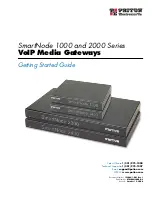
Version 6.6
859
October 2014
Installation & Operation Manual
51. Collecting Traces from the Ethernet Switch Board’s Mirror Port
51
Collecting Traces from the Ethernet
Switch Board’s Mirror Port
Ethernet Switch Boards provide the ability to mirror selective IP traffic that is passed
through the ES boards. Mirrored packets may be duplicated on ES board’s mirror port
and recorded on the external equipment (e.g. PC) connected to this port. Alternatively,
mirrored packets may be sent to the standby SC board and recorded via a standard
network capture utility. Recorded data may be analyzed via regular network analysis
tools – e.g. Wireshark ('http://www.wireshark.org.' 'http://www.wireshark.org.
Different user-defined Mirror Filters may be specified to select packets that will be
mirrored. Multiple filters may be used to capture different kinds of traffic (e.g. call
control and media). Mirror Filters may be activated for the active ES.
Debugging data, captured on the ES board’s mirroring port may be used to
troubleshoot different network-related problems on the Media Gateway, as well as to
validate interoperability between the Media Gateway and 3
rd
party equipment.
To configure Media Gateway to mirror IP traffic, the following tasks must be
performed:
Configure ES Mirror Filters to select IP packets that will be mirrored by each ES
board. Alternatively you may configure ES board to mirror all traffic from the
specific internal IP port (i.e. SC or Media Gateway board).
Configure ES board to record mirrored traffic on Mirror Port or on Standby SC
board.
Start mirroring on ES board.
51.1
Configuring ES Mirror Filters
Mirror filters define which of the IP packets that pass through the specific ES board,
are mirrored by it. Multiple and different mirror filters may be defined on each ES
board.
51.1.1
ES/6600
Mirror filters may be specified either in a “free text” format, where the user explicitly
specifies a range of the bits in the IP packet and the hexadecimal value (e.g. “1-
16=33 134-137=a”), or in a more user-friendly format, where the user may enter the
value of each IP packet’s header element. Header elements, presented to user,
belong to Ethernet, IP, TCP, UDP or ICMP headers. Choose header elements that are
relevant for the specific packets that you are verifying by referring to the figures below.
51.1.2
ES-2
Mirror filters may be specified either by a physical ingress port of ES ,or by IP packet’s
header element. Header elements, presented to user, belong to Ethernet, IP, TCP,
UDP or ICMP headers. Choose header elements that are relevant for the specific
packets that you are verifying by referring to the figures below.
Summary of Contents for Mediant 8000
Page 2: ......
Page 33: ...Part I Hardware Overview This part describes the hardware overview of the Mediant 8000 chassis...
Page 34: ......
Page 90: ......
Page 158: ......
Page 264: ......
Page 546: ......
Page 775: ...Part VI Maintenance This part describes the Mediant 8000 maintenance procedures...
Page 776: ......
Page 834: ......
Page 879: ...Part VIII Appendices This part describes additional Mediant 8000 configuration procedures...
Page 880: ......
Page 924: ...Media Gateway Mediant 8000 www audiocodes com Installation Operation Maintenance Manual...
















































